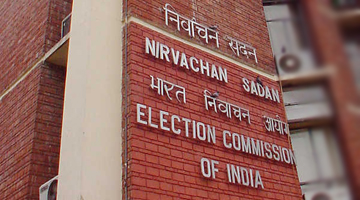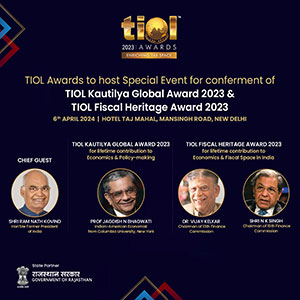TIOL - COB( WEB) - 470
OCTOBER 15, 2015
By Shailendra Kumar, Editor
EVEN as the political stand-off between the BJP and the Congress Party continues to create a ring of smog over the certainty of GST law in India, the credit goes to the Ministry of Finance for yielding to widespread appeal for sharing whatever draft papers were tailored with the trade and industry - one of the key stakeholders in the proposed reform wheel. It is true that the 'disruptive' politics has blurred the 'visibility' of GST roll-out from April 1, 2016 and has also impacted the cohesive decision-making capabilities of the Empowered Committee on GST (their monthly meeting being regularly deferred) but the Union Government has indeed not slowed down the pace of its preparations. Apart from releasing the three Draft papers on GST Registration, Payment & Refund, it has also circulated the Model GST Law among the State Finance Ministers for feedback.
Let's discuss what is in the public domain. The Draft Reports on Payment, Registration & Refund are 87 pages and 52 pages each respectively. In total, they are 191 pages. I wish the North Block could have also prepared five pages summary of each report before releasing the exhaustive and facts-based documents. Ideally, the GST Committee should first have given key highlighting features of the Reports rather than expecting the common taxpayers to read the entire text and understand the nuances of processes being contemplated. That has always been one of the reasons that on most occasions common taxpayers fail to give feedback to our policy makers and it is left to a few dozens industry associations or law firms or audit firms to monopolise the public feedback to the Government. One may go back to either Dr Parthasarthy Shome Committee Reports on various international taxation issues during the UPA regime or the recent Justice A P Shah Committee Report where the key stakeholders were seen to be generally the advisory firms. I wish the Revenue Secretary could ask the GST Committee to quickly prepare brief summary of each of these Reports and share the same with the public.
Let's now begin with the Report on GST Refund. Although the sub-committee which has worked on this Report deserves credit for visualising the maximum possible scenarios under the new system and proposing simple refund procedures different from the present ones but one area where it needs to pay more attention is the refund of accumulated input tax credit (ITC). Given the fact that inverted duty structure is not being ruled out under the proposed system, more attention is required to be paid to ensure how not to hurt the business-doing entities by sitting over piles of ITC. It must be ensured that the legacy of the prevailing ills of the CENVAT Credit system must not be transported to the new system. In this background, the proposal to ill-treat the ITC attributable to accumulation of stock or capital goods is not a good idea at all. Denying refund and forcing a taxpayer to carry forward ITC to next tax period would make the business-doing entity uncompetitive in the market environment.
Yet another unworkable and unheard of idea seems to be that of black-listing of dealers for disallowing availment of credit. The rationale seems to be rooted in the current practice of certain entities issuing bogus invoices but the CENVAT Credit is being availed by a good number of manufacturers and the Department is helpless!! Visualising a similar sort of scenario where a seller collects the tax but does not deposit the same but the purchaser avails the credit. In this scenario, the Draft Proposal is to disallow the ITC and declare the seller blacklisted for the benefit of purchasers who could be alerted before they go for second purchase with them. It is indeed a tricky situation where the Revenue would not like to lose revenue by allowing ITC on an invoice against which tax was not deposited. But in this case even the purchaser is a victim of a fraud. Therefore, the Revenue needs to share the burden of such frauds by allowing at least 50% credit and activating their preventive outfit to go after the fly-by-night operators. Since it would be the combined strength of the Centre and the States there would be greater chances of tracking down the fraudsters who would be submitting certain records with the GSTN Portal at the time of registration and all such details are going to be auto-verified or physical verification is to be done post registration. Although the blacklisting of such entities is going to help purchasers but it would be complete loss for the first time purchasers for no fault of theirs. Let's hope this idea is either further refined or totally dropped.
Let me now go to some good proposals. Kudos to the sub-committee for acknowledging the prevailing market practice of offering year-end or volume-based discounts through credit notes and proposing not to disrupt the same by offering refund option. It is also true that such a practice is being abused by the trade where the downstream dealers tend to project negative value-additions. But no new system should be designed keeping in mind only the fraudsters. It should largely take care of the needs of honest taxpayers at minimum compliance cost. It is indeed a good proposal to allow such a refund based on simple application along with a CA's Certificate certifying the fact of non-passing of the GST burden upto a pre-determined threshold.
The biggest challenge is going to be the case of refund with respect to export of services. Since there are not going to be many Customs documents to verify the export before refund is granted, the two papers on which the GST authorities would have to fall back upon are the invoice and the Bank Realisation Certificate (BRC). Since the requirement of BRC is going to be prior to refund being sanctioned, here is a catch. The efforts should be to source the remittance details from banks directly rather than putting the onus on the service exporters to chase the banks. Since the entire GST regime is going to be operational in an e-enabled environment the onus may be put on banks to upload forex data with some details of exporters unique verification numbers on the GSTN and the same can be matched by the Department before sanctioning the refund. Since the future growth to India's exports kitty is going to come from the services sector, a simple system needs to be put in place right in the beginning.
Another good feature of the Draft Report is the proposed alignment of the refund system for international tourists with the best international practices. Given the fact that the emphasis of the Prime Minister is on providing e-visa to tourists and their inflows would multiply in the coming years, they must be facilitated in terms of granting refund as no country exports taxes. In this backdrop, the Report rightly proposes to encourage shopping of goods during their stay in India and obtain refund of taxes paid at the time of exit. This scheme is proposed to be implemented through registered retailers and refund would be available at designated airports and ports. Ideally, it should be available at all the airports and ports or it would amount to discriminating against certain airports and giving a cause of making allegation by a particular State Government. It is also proposed that like 52 countries where such a system prevails, India would also deduct a minimum handling fee before giving refund.
Let's now visit the Report on Registration. In the GSTIN, it is proposed to adopt the State Code under the Indian Census 2011. With respect to each business vertical, there would be a separate registration of the entity and as many as 35 such verticals can be registered. However, it is indeed a bad idea that for the purpose of recovery of dues the Govt proposes to consider all the separately registered entities as a single legal entity. There appears to be inherent contradictions which seem to be going against the rationale of offering independent registration of each vertical but when it comes to default or recovery, the Department seems to be preferring to miss the woods for the trees.
Let me now refer to one of the very good facilities which GST taxpayers are going to badly miss is the Scheme of Centralised Registration. Since it is going to be Dual GST where each State is a sovereign entity in terms of its taxing rights, the Centralised Registration cannot be implemented. Since the tax base is the same and each State would require separate registration, particularly service providers are going to find it painful. But it is the price which has to be paid for a new system.
Let's hope the final draft of all the three business processes further refine some of the tricky proposals and also retain the beneficial ones. All efforts should be made not to disrupt the seamless credit chain and extra focus should be put on streamlining the refund process. In this context let me recall what the globally known GST expert from Pretoria University Prof Sijbern Cnossen shared with me when he was in Delhi a few months ago - the bane of the EU VAT/GST system is the slow disposal of refund claims. On any day the value of total refund claims is more than USD 19 billion which hurts the taxpayers more than any other procedure. Let's hope the GST-makers in the North Block and the States take extra pain to ensure that India does not fall into the same refund-quagmire!!
|









 Download PDF
Download PDF





